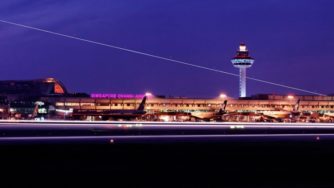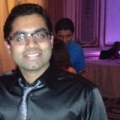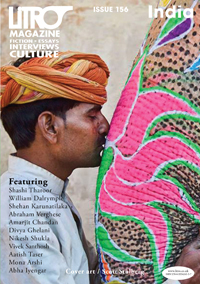You have no items in your cart. Want to get some nice things?
Go shopping I imagined how my father must feel to return to the land of his birth after fifty-two years. More than the physical aspect of traveling long and far it was an adventure of the mind, as the mind tried to match every sight and sound to memories stored in its deepest reserves. As it tried to belong.
I imagined how my father must feel to return to the land of his birth after fifty-two years. More than the physical aspect of traveling long and far it was an adventure of the mind, as the mind tried to match every sight and sound to memories stored in its deepest reserves. As it tried to belong.
In his hand, he held two letters from his father: a one-page handwritten note describing locations and general directions and a barely legible scribble from when he had been terminally ill on the ventilator—a plea to be brought home to die. A wish we did not fulfill.
Yesterday, after a year of planning and coordination, Dad, Mom and I had converged at Singapore’s Changi Airport from Oman, India and the United States. From Singapore, the first leg had been a choppy seventy-minute ride over the South China Sea to Kuching. We were now airborne over East Malaysia to our final destination Miri in the island of Borneo.
Below, a river meandered through thick rainforest and balding farmland like a python sprawled across a green rug, not a care in the world for its deep curves. The occasional patch of white and burgundy sloping roofs seemed alien—almost hostile—to the lush equatorial wilderness.
Much of Borneo’s hinterland had remained unexplored and inaccessible until the discovery of oil in the early twentieth century and an increased demand for timber brought roads, navigable river routes and airways to the world’s oldest rainforest. In the fifties, my grandfather had been employed at the Sarawak Shell Oil Corporation. My grandmother, a math graduate, taught algebra at a local elementary school. When my father was six years old, a civil war broke out in the region forcing the family to return to India. The provinces of Sabah and Sarawak where they had lived went on to join Malaysia, breaking up the island into parts of three nations: Indonesia, with the five Kalimantan provinces comprising three-fourths the area, the minute Kingdom of Brunei comprising about a percent of oil-rich land, and Malaysia, the rest. We were the first members of our family to visit the region after 1962.
“Isn’t this the same steward who served us in the first leg?” my father asked as the meal cart came our way.
I said no, because the crew had changed at Kuching.
“But I’m sure,” he insisted.
“No, Dad, they didn’t leave one behind.”
His mind had already embarked on its adventure.
#
On the day we arrived, Dad took us on a walking tour of the neighborhood. He had done a fair bit of reading in the process of making flight and hotel bookings and knew his way to the city fan, a park constructed in the shape of a medieval fan. What we hadn’t known was that sidewalks were hard to come by in this part of town. We circumvented numerous roadside meat stalls, walked between patio tables of bars, peered for signs of life in a seemingly deserted school, and stared suspiciously at two guys waiting on motorcycles by the side of the road with their engines running. At the park, we tried walking on the “acupuncture stones,” each of us wincing in pain and jumping back to level ground, claiming little health benefit from the brief bout of therapy.
There was a growing mall culture I hadn’t expected to find. Honestly, having done no research myself, I hadn’t known what to expect. But the sight of a Pizza Hut in an unknown land, especially one known to have liberal dietary choices, was oddly comforting.
The next morning, a blue Toyota Innova with glaring yellow seats awaited us outside the front lobby. The hotel had arranged for a local driver to take us sightseeing. David Wong had the permit necessary to cross the border to Brunei. Bandar Seri Bagawan, the capital of the small oil-rich nation, is only 128 kilometers from Miri, but with the visa formalities at the border, we were looking at a three-hour drive. The road was narrow in parts but mostly paved. Except for a handful of townships, the sides of the road were thick with underbrush. In the distance, tall trees raced up to the sky competing for sunlight, closing in on one another, forming the canopy of rainforests.
At the capital, we visited the king’s museum and a couple other tourist spots. As we drove past the Saifuddin Mosque David said the dome was made of “916 gold,” meaning gold of 91.6% purity. He had been delivering such vignettes all along the way. Chatty and cheerful, he had a notorious tendency to break into fits of laughter at the slightest hint of humor. We got along pretty well.
We walked around the city center before stopping for lunch. For the second time in two days we, and especially my vegetarian parents, were thankful for the indiscriminate proliferation of American fast food chains. No matter where you were in the world, you could trust KFC’s waffle fries and Pizza Hut’s veggie lover pizzas with reasonable certainty.
After a lunch of cheese and potato sides at KFC we headed back in the direction of Miri. We first drove through the town of Seria where my father had spent the first year of his life. It was a small oil town by the sea. David said he had worked at a rig off the coast of Seria for twenty-six years before becoming a cab driver. “I like land much better,” he cackled.
Next, we visited the hospital where my father was born, in the town of Kuala Belait. The hospital had been renovated very recently, wiping clean any hope of recognizing it as an integral part of my family’s history. Nevertheless, we unleashed our cameras and added it to the latest chapter.
We crossed the border and drove to the city of Lutong, where the family had moved to from Seria. On the way, we passed by a number of traditional dwellings on stilts. The family had lived in such houses in Seria and Lutong. As a kid Dad would go under the house so his mother could not get to him. Eventually he got hungry and came out. After a scolding and lunch, his mother tied him to the leg of the dining table so she could tend to her chores, until Grandpa returned from work. My father sat there all afternoon until the endearing calls “Appu”—Grandpa’s nickname for Dad—wafted through the front door.
In Lutong, we visited the Recreation Club where Grandpa had served on the executive committee. They had no records from the late fifties. But the manager was gracious enough to show us photos of the club from then and offered to contact us in case he found something. A visit to the Shell office nearby also turned up with nothing. They needed time to dig up old records, time that we didn’t have. My father was disappointed. The era this region had been in and the length of the fifty-two years that had passed in between was becoming more obvious to us now.
The road back to Miri was along the coast. The South China Sea was particularly rough; massive brown waves lashed against the narrow beach. Not a single fishing boat had ventured into the open ocean today. Staring at the waves, I was hypnotized by their raw menace. It was as if every lash was a reminder: “I am Nature, I am Boss.” I imagined the water receding hundreds of meters, revealing debris, plastic bottles, carcasses of sea and land animals alike, leaving fish flipping about in the wet mud… As I gawped at the revelations of the deep sea, a solid brown wall rose in the horizon. It grew as high as the eye could see and started moving towards the shore.
I shook off my unwarranted imagination of catastrophes and concentrated on the road. A few days later, Air Asia flight QZ8501 was lost in stormy weather over the South China Sea.
#
David brought his wife along the next day. A newer white Innova with beige interiors had replaced the blue one with its eyesore seats. It was his son’s, who had become a cab driver just like him.
“I told my children to study, but they want to make money. Such stupids!” he chortled.
The day was reserved for sightseeing. We were going to Niah caves, 70 kilometers southwest of Miri. As we approached Batu Niah, the mostly flat, low-lying land rose sharply in the horizon to thickly forested, near-vertical rock faces. Batu Niah is home to an ancient limestone cave complex, carved into the side of the mountain. What we hadn’t known beforehand was there was a hike up to the mouth of the Great Cave. David had brought his wife along to keep him company while we were gone on our “long trek”.
Unprepared as we were, we decided to give it a shot anyway and bought park entry tickets. The price also covered the world’s shortest ferry ride across the narrow, yellow Sungai Niah. At the dock, a sign said “Beware of crocodiles.” The river was notorious for its croc population. Every now and then, their numbers would swell and starve the river of its resources. As a result, unsuspecting humans would be stolen at night or sometimes, in the case of really hungry crocs, in broad daylight.
After an uneventful crossing, we started trekking through thick vegetation. The trail was well maintained but slick from recent rain. There was not another hiker soul in sight. The forest enveloped us from either side. It was quite alive and noisy: crickets chirped, odd screeches and ominous tick-tocks emanated from its depths. Mom and I started slowing down, doubting the safety of the trail. I imagined creatures watching us from heights through camouflage, tracking our moves, teasing us with their other-worldly sounds. “Oooo, let me swallow the fat one, he’ll last weeks.” “I don’t fancy older women either. Share with me some young and fresh, he looks delicious.”
Brave as I was, I voiced my concerns rather strongly. Soon, we were walking back, with Dad insisting in vain that the trail was perfectly safe. David roared with laughter when we returned in a jiffy. I learned later, not without a pang of regret, that Niah Caves was home to some of the world’s oldest human remains, dating back about 40,000 years and beautiful prehistoric cave paintings from early human settlements.
At Batu Niah town center, a huge warehouse had been converted into a shopping complex of sorts with a department store, vegetable and fruit stalls, a food court, and what looked like an urban zoo. Right by where customers sat and ate, there were cages and tanks carrying reptiles and amphibians. I was amazed and repelled by the sight of what David called a “king dragon turtle.” If there were ever genetically modified turtles that could be trained in ninjutsu, it was these guys. This particular one however was way past its teens, with claws so long they curled under the feet, a rough hardened armor, long scaly tail, and a strong unwillingness to move. Kids crowded around an albino ball python’s cage, prodding it with straws. The braver ones poked it with their fingers. Having given up on life after years of depraving captivity and human bullying, the snake moved ever so slightly to show it wasn’t yet time to pour kerosene over and light it.
David then took us to an Iban longhouse settlement. Fifty shotgun shacks had been built side-by-side on tall wooden stilts, each sharing walls with its neighbors except the ones on the ends. The entrance to each house actually led to a massive common hall. On the other side of the hall were the real front doors leading into the longhouses. Children played in the hall while adults basked in the sun filtering through the windows. David exchanged pleasantries with some of the residents. A man in his late twenties hunched over a laptop playing Call of Duty as two kids watched, glued to the headshots and explosions. About halfway down the hall, human skulls hung in a basket overhead. The Dayak tribes had been headhunters by tradition before the government had outlawed this fun activity.
Back outside, David asked us if we took any photos of the skulls. We didn’t, because it had felt like an invasion of the residents’ privacy. He sighed in relief and said, good, for otherwise we would have brought back the spirits with us. Surely those wandering headless souls had left long ago with some brave photographer before us. Going along David’s trajectory of superstition, I imagined the gruesome baggage people who photographed uncovered mass graves must have carried back. In more ways than one, they would have been haunted for the rest of their lives.
Our last stop was the 104-year-old Grand Old Lady on Canada Hill, the first oil well in the region. Though no longer functional, it was Miri’s raison d’être. The looming metal structure watched over the city from above, an everyday reminder for how it had all begun.
After David dropped us back at the hotel, my parents left for a stroll around the neighborhood. I stayed back. Had Dad achieved mission objectives? Little remained of the Seria and Lutong he left behind as a kid. He had hoped to meet at least one person who remembered his parents—perhaps a relative or a descendant of Sari, the Dayak maid who had taken care of the children while the parents worked, or a colleague of my grandmother from the school she had taught in—but we hadn’t met any. We embarked on this trip with a lot of anticipation and excitement, perhaps a fraction of what my intrepid grandfather had felt when he left home at the age of eighteen, and shortly thereafter the country of his birth, armed with a knowledge of shorthand and an excellent words-per-minute on a mechanical typewriter. Once when I asked the silver-haired octogenarian how he had done it he simply chuckled. Instead, he lamented about being made to repeat sixth and ninth grades, the former because he failed and the latter because he broke his right hand. My grandfather hadn’t thought much of his education, which was little to begin with, but what he achieved over the course of his life transcended an average life of self-accomplishments. He brought his family, his wife’s family, and of those around him to education and prosperity by bringing them overseas, getting them jobs, sending them money to study or start businesses of their own.
The ripples of my grandparents’ lives are still felt today, years after their deaths. There is no need for any validation for it is self-evident. Therefore, I decided the purpose of our visit had been for Dad to remember them more intimately as their son, more personally than through legend, so he could renew the calls “Appu” to his five-year old self, imagine how they had made it work more than a half-century ago in a primitive and completely foreign land. Most importantly, it had been for him to make peace with the fact that as we continue to live with their memories, Miri, Lutong and Seria live on, changing with and adapting to the times, glimpses of their past in a street corner or on a hilltop, reminding us how far they have come.

About Vivek Santosh
Vivek Santhosh is a writer living in the San Francisco Bay Area. He was raised in India and Oman. An engineer by profession, he lived in Atlanta and Boston before moving west to Silicon Valley. When not writing or travelling, he enjoys reading and play- ing Ultimate Frisbee.





Moving and visual writing. Could imagine places never visited. Great treat Vivek, waiting for more. Good luck!!!
Very nice story.. Very fluence language! Good work! :)
That completes the findings!
Support Hillary!! Trump sucks